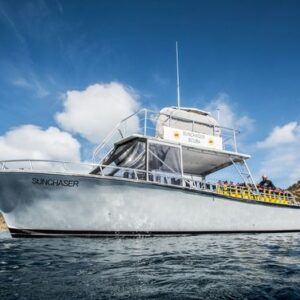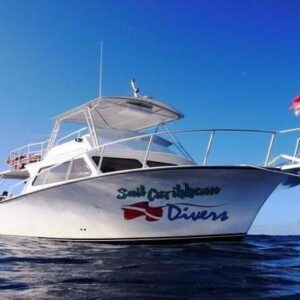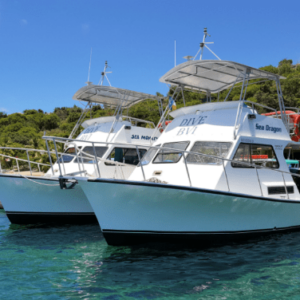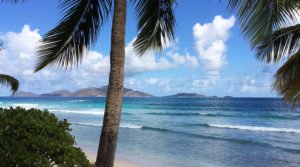
GETTING THERE
-
If you’re visiting from the U.S. (or most other countries), you will need a passport in order to enter the BVI.
-
The British Virgin Island’s main airport is the Terrance B. Lettsome Airport (EIS), located on Beef Island (a small island off the main island of Tortola).
-
Please note that if you are traveling from the U.S., you will not be able to catch a direct flight to the BVI.
-
-
While neither Uber or Lyft operate in the BVI, travel is fairly easy on the islands. Options include taxis, car rentals, ferries and even helicopters!
GOOD TO KNOW
-
The British Virgin Islands is a British overseas territory, meaning it’s under the jurisdiction of the U.K.
-
Time zone: Atlantic Standard Time
-
Primary language: English
-
Currency: U.S. dollar. Credit cards are also readily accepted.
-
Phone and internet: Phone service is available from U.S. phone carriers (just be sure to check with your carrier on roaming rates first). Internet is easy to find and many restaurants offer free WiFi. The international calling code is +1.
-
Voltage: 110 V (similar to that of the U.S. and Canada).
-
Hurricane season in the BVI runs from June to November, peaking from August to October.
-
There are currently no U.S. travel advisories for the British Virgin Islands.
-
Don’t forget to dive on the left side of the road.
DIVE CONDITIONS
-
Water temperature ranges from 77 degrees Fahrenheit in the winter to 86 degrees in the summer.
-
Average water visibility is 60 to 100 feet.
-
WHEN TO GO
-
You can scuba dive in the British Virgin Islands year round. In the winter, conditions are a bit rougher but the visibility is better.
-
You’re most likely to see marine life from October to May in the BVI.
-
Peak season for tourism in the British Virgin Islands is from December to February.
-
-
WHAT YOU’LL SEE
-
Divers can expect to see an array of vibrant reef fish, sea turtles, barracuda, lobsters and more. There are also an abundance of shipwrecks, caves and tunnels to explore.
-
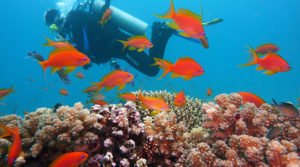
BEST SCUBA DIVING IN THE BRITISH VIRGIN ISLANDS
THE AQUARIUM
In the Southwest of Virgin Gorda, between The Baths and Spanish Town you’ll find this popular dive site. Teeming with colorful fish, blue tangs, moray eels and nurse sharks, this is a must-dive for anyone visiting the BVI. You’re sure to lose yourself among small caverns and caves as vibrant fish swirl around you. At a depth of 30 feet with low currents, this spot is great for beginners.
DIAMOND REEF
A two-minute boat ride from Scrub Island brings you to Diamond Reef, where you’ll find colorful corals and a wide variety of marine life. If you’re lucky, you might find yourself swimming alongside a sea turtle. You’ll also want to keep your eye out for all things glittery – a woman lost her diamond ring in this spot years ago, giving this diving location its name. At a depth of 40 feet, with low currents, this is an ideal dive for beginners and intermediate divers.
WRECK ALLEY
Just off the coast of Cooper Island, Wreck Alley contains four (yes, four!) shipwrecks just waiting to be explored. Bright corals and sponges have grown on most of these sunken ships, but you can also expect to see grunts, parrot fish, stingrays and eels. The shipwrecks make a perfect habitat for marine life. With a depth of about 88 feet and a moderate swell, this site is best suited for intermediate divers.
RMS RHONE
Ah, the RMS Rhone—one of the most popular dive site in all of the British Virgin Islands. This site is home to a Royal Mail Steamship that sunk in 1867. What’s unique about this wreck is how much of the ship remains intact today. Divers will want to be sure to make time for two dives to see both the bow and stern sections of the RMS Rhone. As for marine life in this area, expect to see barracudas, stingrays, angelfish, and the occasional octopus. With a depth of 90 feet, low currents and a moderate swell, intermediate, advanced and expert divers will thrive here.
CHIKUZEN
Located between Tortola and Anegada, this BVI dive spot is named after the refrigerator vessel that sunk there. Exploding with color and unique sea life (think: saucereye porgy and Atlantic spadefish), you may even catch a glimpse of the famous 600 lb grouper that hangs out around here. At 75 feet deep with a high swell, this dive is best suited for advanced scuba divers.
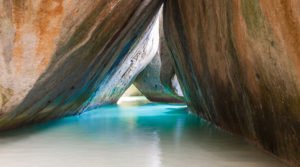
BEST SNORKELING IN THE BRITISH VIRGIN ISLANDS
THE BATHS
On the southwest coast of Virgin Gorda, you’ll find this serene snorkeling paradise. Home to grottoes, caves, and colorful fish, you’ll enjoy the stunning views above and below water. The giant boulders decorating the landscape make it a unique experience for visitors and a great place for photos. At a depth of 40 feet with low currents, this is a beginner’s dream.
RAINBOW CANYONS
A short distance north of Norman Island, you’ll find this colorful snorkeling adventure. Spotted drums, garden eels and nurse sharks will accompany you through the kaleidoscope of sea life in this vibrant snorkeling spot. Rainbow Canyons has a depth of 60 feet, but the calm waters and low current make it an excellent place for beginners.
THE CAVES
Located on Norman Island (the inspiration for the book Treasure Island), The Caves are one of the most popular snorkeling locations in the British Virgin Islands. From red sponges to yellowtail snappers, there’s no end to the marine life you’ll see at this spot. You may even glide past a few squids on your swim! At nearly 50 feet deep with a low current, The Caves are best suited for intermediate snorkelers.
GREAT DOG
The Dogs are a group of five islands to the west of Virgin Gorda. Great Dog, in particular, is an ideal island for snorkeling, boasting bright corals and reef fish. Depth ranges from 10 feet to 60 feet, with low currents and calm waters (as long as the north swell isn’t up). This secluded location is a good spot for intermediate snorkelers.
DISCOVER UNIQUE THINGS TO DO IN THE BRITISH VIRGIN ISLANDS
YACHT & BOAT TOURS
Spend a day above water as you glide over the crystal blue waters in a sailboat or yacht. Whether you’re just going from one island to the next, or relaxing onboard for the day, it’s a great way to experience the British Virgin Islands.
SAGE MOUNTAIN NATIONAL PARK
Sage Mountain National Park, located in Tortola, offers hiking trails with stunning views. You’ll need about two to three hours to complete one of these rainforest trails, but the photos will be worth it!
SUGARCANE RESTAURANT
If you’re looking for a little luxury, head to Sugarcane Restaurant, located on Virgin Gorda at the Nail Bay Sports Club. While some club amenities are limited to members, Sugarcane is open to the public, offering gorgeous poolside views, all day dining and an extensive bar menu.
CANE GARDEN BAY BEACH
Ready for an action-packed day at the beach? Cane Garden Bay Beach offers windsurfing, water sports and a lively bar scene. Spend the day on the water, then sit back with a cocktail to catch the sunset!

